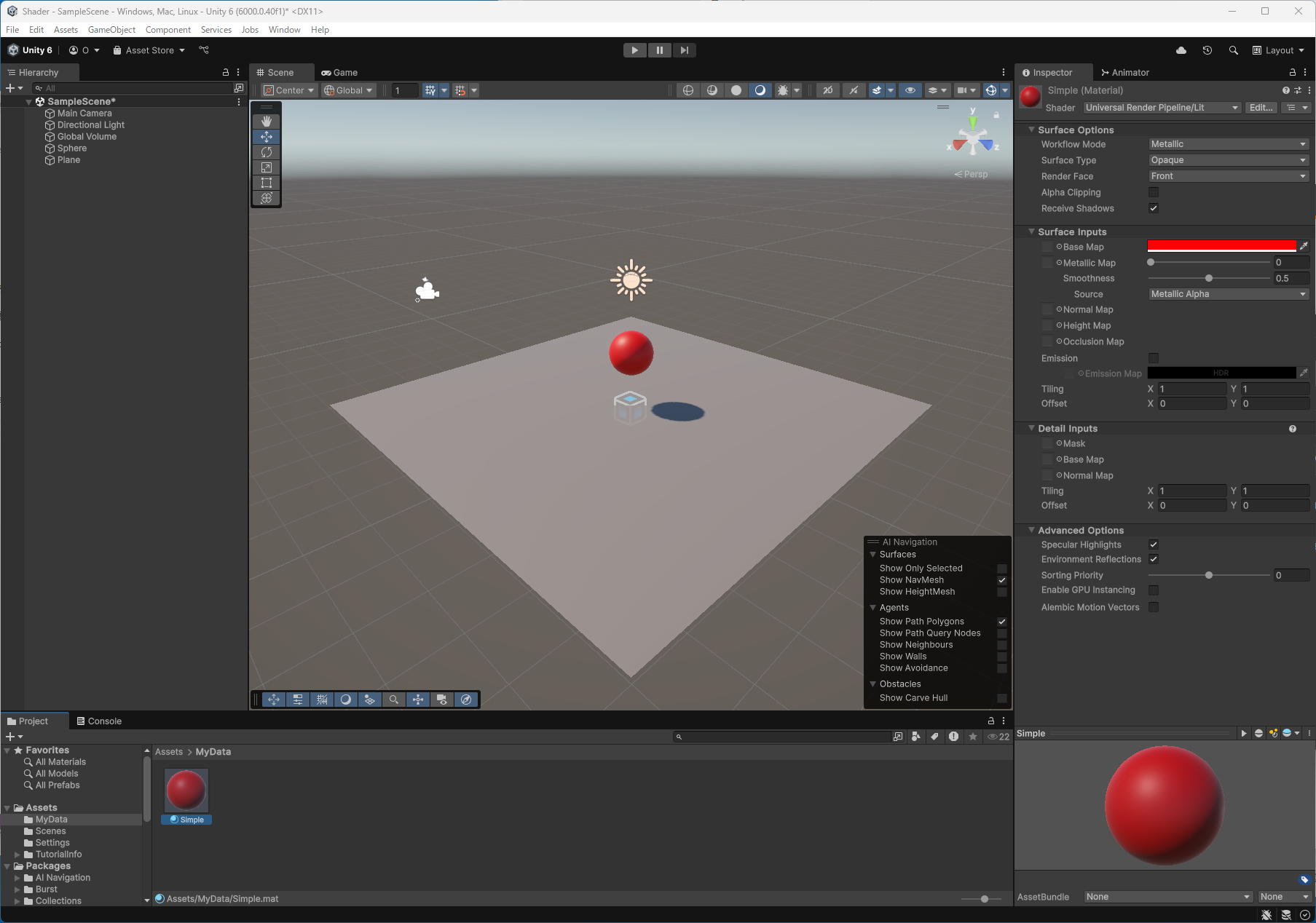Unityのシェーダーを学ぶ
サンプルシーンを作る
まず、現時点のUnityの最新バージョンは、6000.0.40f1 でしたので、こちらを使ってシェーダーのコードを調べてみます。
Unityには描画パイプラインが、 Build-in 、 URP 、 HDRP の3種類あります。現在、主に使われているのは URP だと思いますので、URP を使ってプロジェクトを作ります。まず、シーンの床面として、Planeを配置して、Sphereを1つその上に起きます。そして、Materialを新規作成し、BaseMapのカラーを赤色を設定して、Sphereに適用するとこのような画面になります。
Lit シェーダーのコードを開く
上記で、 Universal Render Pipeline/Lit というシェーダー名が表示されたところに、Edit ボタンがあります。こちらを押すことで、 Lit シェーダーのコードを開くことができます。
まず、ファイルが開いたら、どのフォルダに置いてあるか、確認しておきましょう。
私の場合、
Library\PackageCache\com.unity.render-pipelines.universal@bd2aa618476e\Shaders
フォルダの中に、 Lit.shader がありました。ただし、パスの中にハッシュ値が入っているので、バージョンや環境の違いによってハッシュ値は変わってくると思います。
PBR のライティング計算を読む
Lit.shader には複数の Pass が書かれてます。Unity は、フォワードレンダリングを使っている人が多いと思いますので、今回は、ForwardLitという Pass を確認します。デファードレンダリングを知りたい人は、GBuffer のパスを参照してください。
ForwardLit のコードを読むと、以下のように、コードをインクルードしています。
#include "Packages/com.unity.render-pipelines.universal/Shaders/LitForwardPass.hlsl"
こちらのパスは、先ほど調べた Lit.shader のファイルが置いてあるフォルダと同じ場所ですので、そちらの、 LitForwardPass.hlsl を開きます。
LitPassVertex が Vertex シェーダーであり、LitPassFragment が Pixel シェーダーのコードになります。
今回は PBR のライティング計算を調べたいと思っていますので、LitPassFragment を読んでみると、ライティング処理は、
half4 color = UniversalFragmentPBR(inputData, surfaceData);
こちらで計算しているようです。こちらの関数は、どこで定義されているか検索してみると、隣のフォルダの ShaderLibrary/Lighting.hlsl で定義されているようです。
////////////////////////////////////////////////////////////////////////////////
/// PBR lighting...
////////////////////////////////////////////////////////////////////////////////
half4 UniversalFragmentPBR(InputData inputData, SurfaceData surfaceData)
{
#if defined(_SPECULARHIGHLIGHTS_OFF)
bool specularHighlightsOff = true;
#else
bool specularHighlightsOff = false;
#endif
BRDFData brdfData;
// NOTE: can modify "surfaceData"...
InitializeBRDFData(surfaceData, brdfData);
#if defined(DEBUG_DISPLAY)
half4 debugColor;
if (CanDebugOverrideOutputColor(inputData, surfaceData, brdfData, debugColor))
{
return debugColor;
}
#endif
// Clear-coat calculation...
BRDFData brdfDataClearCoat = CreateClearCoatBRDFData(surfaceData, brdfData);
half4 shadowMask = CalculateShadowMask(inputData);
AmbientOcclusionFactor aoFactor = CreateAmbientOcclusionFactor(inputData, surfaceData);
uint meshRenderingLayers = GetMeshRenderingLayer();
Light mainLight = GetMainLight(inputData, shadowMask, aoFactor);
// NOTE: We don't apply AO to the GI here because it's done in the lighting calculation below...
MixRealtimeAndBakedGI(mainLight, inputData.normalWS, inputData.bakedGI);
LightingData lightingData = CreateLightingData(inputData, surfaceData);
lightingData.giColor = GlobalIllumination(brdfData, brdfDataClearCoat, surfaceData.clearCoatMask,
inputData.bakedGI, aoFactor.indirectAmbientOcclusion, inputData.positionWS,
inputData.normalWS, inputData.viewDirectionWS, inputData.normalizedScreenSpaceUV);
#ifdef _LIGHT_LAYERS
if (IsMatchingLightLayer(mainLight.layerMask, meshRenderingLayers))
#endif
{
lightingData.mainLightColor = LightingPhysicallyBased(brdfData, brdfDataClearCoat,
mainLight,
inputData.normalWS, inputData.viewDirectionWS,
surfaceData.clearCoatMask, specularHighlightsOff);
}
#if defined(_ADDITIONAL_LIGHTS)
uint pixelLightCount = GetAdditionalLightsCount();
#if USE_FORWARD_PLUS
[loop] for (uint lightIndex = 0; lightIndex < min(URP_FP_DIRECTIONAL_LIGHTS_COUNT, MAX_VISIBLE_LIGHTS); lightIndex++)
{
FORWARD_PLUS_SUBTRACTIVE_LIGHT_CHECK
Light light = GetAdditionalLight(lightIndex, inputData, shadowMask, aoFactor);
#ifdef _LIGHT_LAYERS
if (IsMatchingLightLayer(light.layerMask, meshRenderingLayers))
#endif
{
lightingData.additionalLightsColor += LightingPhysicallyBased(brdfData, brdfDataClearCoat, light,
inputData.normalWS, inputData.viewDirectionWS,
surfaceData.clearCoatMask, specularHighlightsOff);
}
}
#endif
LIGHT_LOOP_BEGIN(pixelLightCount)
Light light = GetAdditionalLight(lightIndex, inputData, shadowMask, aoFactor);
#ifdef _LIGHT_LAYERS
if (IsMatchingLightLayer(light.layerMask, meshRenderingLayers))
#endif
{
lightingData.additionalLightsColor += LightingPhysicallyBased(brdfData, brdfDataClearCoat, light,
inputData.normalWS, inputData.viewDirectionWS,
surfaceData.clearCoatMask, specularHighlightsOff);
}
LIGHT_LOOP_END
#endif
#if defined(_ADDITIONAL_LIGHTS_VERTEX)
lightingData.vertexLightingColor += inputData.vertexLighting * brdfData.diffuse;
#endif
#if REAL_IS_HALF
// Clamp any half.inf+ to HALF_MAX
return min(CalculateFinalColor(lightingData, surfaceData.alpha), HALF_MAX);
#else
return CalculateFinalColor(lightingData, surfaceData.alpha);
#endif
}
まだ、この関数を読んでも、ライティングの計算式は出てきませんね。次は、LightingPhysicallyBased です。
half3 LightingPhysicallyBased(BRDFData brdfData, BRDFData brdfDataClearCoat,
half3 lightColor, half3 lightDirectionWS, float lightAttenuation,
half3 normalWS, half3 viewDirectionWS,
half clearCoatMask, bool specularHighlightsOff)
{
half NdotL = saturate(dot(normalWS, lightDirectionWS));
half3 radiance = lightColor * (lightAttenuation * NdotL);
half3 brdf = brdfData.diffuse;
#ifndef _SPECULARHIGHLIGHTS_OFF
[branch] if (!specularHighlightsOff)
{
brdf += brdfData.specular * DirectBRDFSpecular(brdfData, normalWS, lightDirectionWS, viewDirectionWS);
#if defined(_CLEARCOAT) || defined(_CLEARCOATMAP)
// Clear coat evaluates the specular a second timw and has some common terms with the base specular.
// We rely on the compiler to merge these and compute them only once.
half brdfCoat = kDielectricSpec.r * DirectBRDFSpecular(brdfDataClearCoat, normalWS, lightDirectionWS, viewDirectionWS);
// Mix clear coat and base layer using khronos glTF recommended formula
// https://github.com/KhronosGroup/glTF/blob/master/extensions/2.0/Khronos/KHR_materials_clearcoat/README.md
// Use NoV for direct too instead of LoH as an optimization (NoV is light invariant).
half NoV = saturate(dot(normalWS, viewDirectionWS));
// Use slightly simpler fresnelTerm (Pow4 vs Pow5) as a small optimization.
// It is matching fresnel used in the GI/Env, so should produce a consistent clear coat blend (env vs. direct)
half coatFresnel = kDielectricSpec.x + kDielectricSpec.a * Pow4(1.0 - NoV);
brdf = brdf * (1.0 - clearCoatMask * coatFresnel) + brdfCoat * clearCoatMask;
#endif // _CLEARCOAT
}
#endif // _SPECULARHIGHLIGHTS_OFF
return brdf * radiance;
}
一部ライティング計算が出てきました。次は、反射光に関して、DirectBRDFSpecular です。この関数は、 ShaderLibrary/BRDF.hlsl で定義されています。
// Computes the scalar specular term for Minimalist CookTorrance BRDF
// NOTE: needs to be multiplied with reflectance f0, i.e. specular color to complete
half DirectBRDFSpecular(BRDFData brdfData, half3 normalWS, half3 lightDirectionWS, half3 viewDirectionWS)
{
float3 lightDirectionWSFloat3 = float3(lightDirectionWS);
float3 halfDir = SafeNormalize(lightDirectionWSFloat3 + float3(viewDirectionWS));
float NoH = saturate(dot(float3(normalWS), halfDir));
half LoH = half(saturate(dot(lightDirectionWSFloat3, halfDir)));
// GGX Distribution multiplied by combined approximation of Visibility and Fresnel
// BRDFspec = (D * V * F) / 4.0
// D = roughness^2 / ( NoH^2 * (roughness^2 - 1) + 1 )^2
// V * F = 1.0 / ( LoH^2 * (roughness + 0.5) )
// See "Optimizing PBR for Mobile" from Siggraph 2015 moving mobile graphics course
// https://community.arm.com/events/1155
// Final BRDFspec = roughness^2 / ( NoH^2 * (roughness^2 - 1) + 1 )^2 * (LoH^2 * (roughness + 0.5) * 4.0)
// We further optimize a few light invariant terms
// brdfData.normalizationTerm = (roughness + 0.5) * 4.0 rewritten as roughness * 4.0 + 2.0 to a fit a MAD.
float d = NoH * NoH * brdfData.roughness2MinusOne + 1.00001f;
half LoH2 = LoH * LoH;
half specularTerm = brdfData.roughness2 / ((d * d) * max(0.1h, LoH2) * brdfData.normalizationTerm);
// On platforms where half actually means something, the denominator has a risk of overflow
// clamp below was added specifically to "fix" that, but dx compiler (we convert bytecode to metal/gles)
// sees that specularTerm have only non-negative terms, so it skips max(0,..) in clamp (leaving only min(100,...))
#if REAL_IS_HALF
specularTerm = specularTerm - HALF_MIN;
// Update: Conservative bump from 100.0 to 1000.0 to better match the full float specular look.
// Roughly 65504.0 / 32*2 == 1023.5,
// or HALF_MAX / ((mobile) MAX_VISIBLE_LIGHTS * 2),
// to reserve half of the per light range for specular and half for diffuse + indirect + emissive.
specularTerm = clamp(specularTerm, 0.0, 1000.0); // Prevent FP16 overflow on mobiles
#endif
return specularTerm;
}
やっと、PBR のライティング計算までたどり着きました。
Lit をカスタマイズしてシェーダーを作りたい場合は、この辺をコピーして、カスタマイズすればいいと思います。
とりあえず、今回はここまで。

